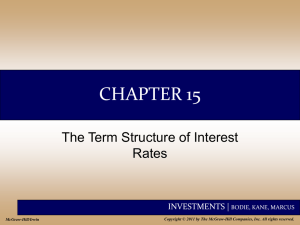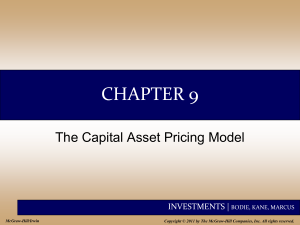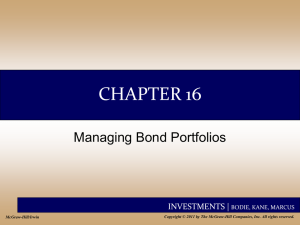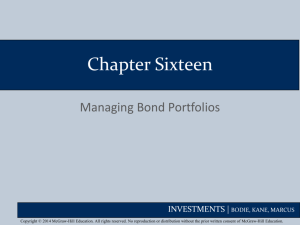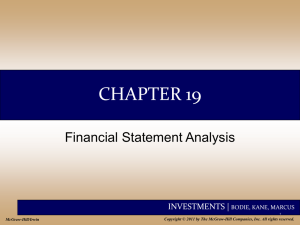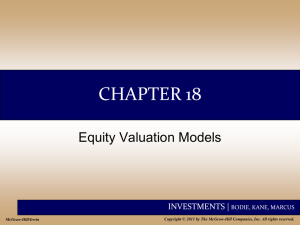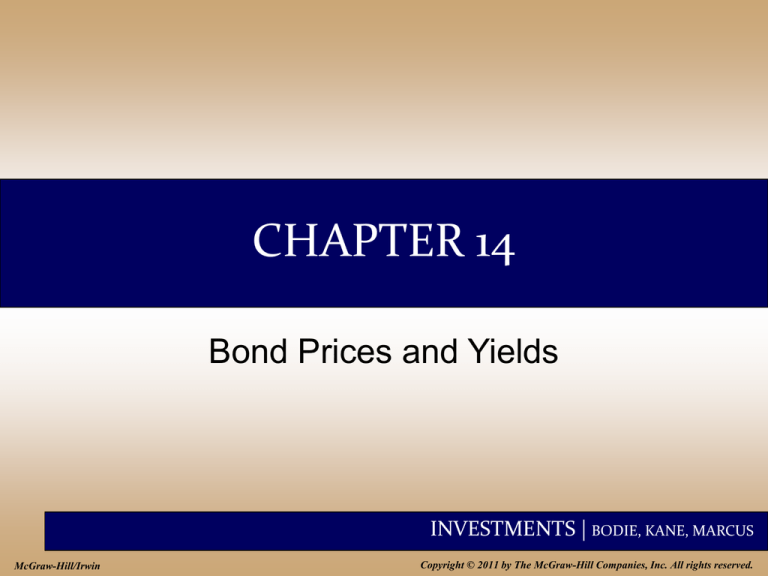
CHAPTER 14
Bond Prices and Yields
INVESTMENTS | BODIE, KANE, MARCUS
McGraw-Hill/Irwin
Copyright © 2011 by The McGraw-Hill Companies, Inc. All rights reserved.
14-2
Bond Characteristics
• Bonds are debt. Issuers are
borrowers and holders are creditors.
– The indenture is the contract between
the issuer and the bondholder.
– The indenture gives the coupon rate,
maturity date, and par value.
INVESTMENTS | BODIE, KANE, MARCUS
14-3
Bond Characteristics
• Face or par value is typically $1000; this is
the principal repaid at maturity.
• The coupon rate determines the interest
payment.
– Interest is usually paid semiannually.
– The coupon rate can be zero.
– Interest payments are called “coupon
payments”.
INVESTMENTS | BODIE, KANE, MARCUS
14-4
U.S. Treasury Bonds
•Note maturity
is 1-10 years
•Bond maturity
is 10-30 years
• Bonds and notes may be
purchased directly from
the Treasury.
• Denomination can be as
small as $100, but
$1,000 is more common.
• Bid price of 100:08
means 100 8/32 or
$1002.50
INVESTMENTS | BODIE, KANE, MARCUS
14-5
Corporate Bonds
• Callable bonds can be repurchased before
the maturity date.
• Convertible bonds can be exchanged for
shares of the firm’s common stock.
• Puttable bonds give the bondholder the
option to retire or extend the bond.
• Floating rate bonds have an adjustable
coupon rate
INVESTMENTS | BODIE, KANE, MARCUS
14-6
Preferred Stock
•Equity
•Fixed income
• Dividends are paid in
perpetuity.
• Nonpayment of dividends
does not mean
bankruptcy.
• Preferred dividends are
paid before common.
• No tax break.
INVESTMENTS | BODIE, KANE, MARCUS
14-7
Innovation in the Bond Market
•
•
•
•
Inverse Floaters
Asset-Backed Bonds
Catastrophe Bonds
Indexed Bonds
–Treasury Inflation Protected
Securities (TIPS).
INVESTMENTS | BODIE, KANE, MARCUS
14-8
Table 14.1 Principal and Interest Payments
for a Treasury Inflation Protected Security
INVESTMENTS | BODIE, KANE, MARCUS
14-9
Bond Pricing
ParValue
C
PB
T
t
(1 r )
t 1 (1 r )
T
PB = Price of the bond
Ct = interest or coupon payments
T = number of periods to maturity
r = semi-annual discount rate or the semi-annual
yield to maturity
INVESTMENTS | BODIE, KANE, MARCUS
14-10
Example 14.2: Bond Pricing
Price of a 30 year, 8% coupon bond.
Market rate of interest is 10%.
60
$40
$1000
Price
t
60
1.05
t 1 1.05
Price $810 .71
INVESTMENTS | BODIE, KANE, MARCUS
14-11
Bond Prices and Yields
• Prices and yields (required rates of
return) have an inverse relationship
• The bond price curve (Figure 14.3) is
convex.
• The longer the maturity, the more
sensitive the bond’s price to changes in
market interest rates.
INVESTMENTS | BODIE, KANE, MARCUS
14-12
Figure 14.3 The Inverse Relationship
Between Bond Prices and Yields
INVESTMENTS | BODIE, KANE, MARCUS
14-13
Table 14.2 Bond Prices at
Different Interest Rates
INVESTMENTS | BODIE, KANE, MARCUS
14-14
Yield to Maturity
• Interest rate that makes the present
value of the bond’s payments equal
to its price is the YTM.
Solve the bond formula for r
ParValue
C
PB
T
t
(1 r )
t 1 (1 r )
T
INVESTMENTS | BODIE, KANE, MARCUS
14-15
Yield to Maturity Example
Suppose an 8% coupon, 30 year bond
is selling for $1276.76. What is its
average rate of return?
$40 1000
$1276.76
60
t
(1 r )
t 1 (1 r )
60
r = 3% per half year
Bond equivalent yield = 6%
EAR = ((1.03)2)-1=6.09%
INVESTMENTS | BODIE, KANE, MARCUS
14-16
YTM vs. Current Yield
YTM
Current Yield
• The YTM is the bond’s
internal rate of return.
• YTM is the interest rate
that makes the present
value of a bond’s
payments equal to its
price.
• YTM assumes that all
bond coupons can be
reinvested at the YTM
rate.
• The current yield is the
bond’s annual coupon
payment divided by the
bond price.
• For bonds selling at a
premium, coupon rate >
current yield>YTM.
• For discount bonds,
relationships are reversed.
INVESTMENTS | BODIE, KANE, MARCUS
14-17
Yield to Call
• If interest rates fall, price of straight bond
can rise considerably.
• The price of the callable bond is flat over a
range of low interest rates because the
risk of repurchase or call is high.
• When interest rates are high, the risk of
call is negligible and the values of the
straight and the callable bond converge.
INVESTMENTS | BODIE, KANE, MARCUS
14-18
Figure 14.4 Bond Prices: Callable and Straight
Debt
INVESTMENTS | BODIE, KANE, MARCUS
14-19
Realized Yield versus YTM
• Reinvestment Assumptions
• Holding Period Return
– Changes in rates affect returns
– Reinvestment of coupon payments
– Change in price of the bond
INVESTMENTS | BODIE, KANE, MARCUS
14-20
Figure 14.5 Growth of Invested Funds
INVESTMENTS | BODIE, KANE, MARCUS
14-21
Figure 14.6 Prices over Time of 30-Year
Maturity, 6.5% Coupon Bonds
INVESTMENTS | BODIE, KANE, MARCUS
14-22
YTM vs. HPR
YTM
HPR
• YTM is the average
return if the bond is held
to maturity.
• YTM depends on coupon
rate, maturity, and par
value.
• All of these are readily
observable.
• HPR is the rate of return
over a particular
investment period.
• HPR depends on the
bond’s price at the end of
the holding period, an
unknown future value.
• HPR can only be
forecasted.
INVESTMENTS | BODIE, KANE, MARCUS
14-23
Figure 14.7 The Price of a 30-Year ZeroCoupon Bond over Time
INVESTMENTS | BODIE, KANE, MARCUS
14-24
Default Risk and Bond Pricing
• Rating companies:
– Moody’s Investor Service, Standard &
Poor’s, Fitch
• Rating Categories
– Highest rating is AAA or Aaa
– Investment grade bonds are rated BBB
or Baa and above
– Speculative grade/junk bonds have
ratings below BBB or Baa.
INVESTMENTS | BODIE, KANE, MARCUS
14-25
Factors Used by Rating Companies
•
•
•
•
•
Coverage ratios
Leverage ratios
Liquidity ratios
Profitability ratios
Cash flow to debt
INVESTMENTS | BODIE, KANE, MARCUS
14-26
Table 14.3 Financial Ratios and Default
Risk by Rating Class, Long-Term Debt
INVESTMENTS | BODIE, KANE, MARCUS
14-27
Figure 14.9 Discriminant Analysis
INVESTMENTS | BODIE, KANE, MARCUS
14-28
Protection Against Default
• Sinking funds – a way to call bonds
early
• Subordination of future debt– restrict
additional borrowing
• Dividend restrictions– force firm to
retain assets rather than paying them
out to shareholders
• Collateral – a particular asset
bondholders receive if the firm defaults
INVESTMENTS | BODIE, KANE, MARCUS
14-29
Default Risk and Yield
• The risk structure of interest rates refers
to the pattern of default premiums.
• There is a difference between the yield
based on expected cash flows and yield
based on promised cash flows.
• The difference between the expected
YTM and the promised YTM is the default
risk premium.
INVESTMENTS | BODIE, KANE, MARCUS
14-30
Figure 14.11 Yield Spreads
INVESTMENTS | BODIE, KANE, MARCUS
14-31
Credit Default Swaps
• A credit default swap (CDS) acts like an
insurance policy on the default risk of a
corporate bond or loan.
• CDS buyer pays annual premiums.
• CDS issuer agrees to buy the bond in a
default or pay the difference between par
and market values to the CDS buyer.
INVESTMENTS | BODIE, KANE, MARCUS
14-32
Credit Default Swaps
• Institutional bondholders, e.g. banks, used
CDS to enhance creditworthiness of their
loan portfolios, to manufacture AAA debt.
• CDS can also be used to speculate that
bond prices will fall.
• This means there can be more CDS
outstanding than there are bonds to
insure!
INVESTMENTS | BODIE, KANE, MARCUS
14-33
Figure 14.12 Prices of Credit Default
Swaps
INVESTMENTS | BODIE, KANE, MARCUS
14-34
Credit Risk and Collateralized Debt
Obligations (CDOs)
• Major mechanism to reallocate credit risk
in the fixed-income markets
– Structured Investment Vehicle (SIV)
often used to create the CDO
– Loans are pooled together and split
into tranches with different levels of
default risk.
– Mortgage-backed CDOs were an
investment disaster in 2007
INVESTMENTS | BODIE, KANE, MARCUS
14-35
Figure 14.13 Collateralized Debt
Obligations
INVESTMENTS | BODIE, KANE, MARCUS


